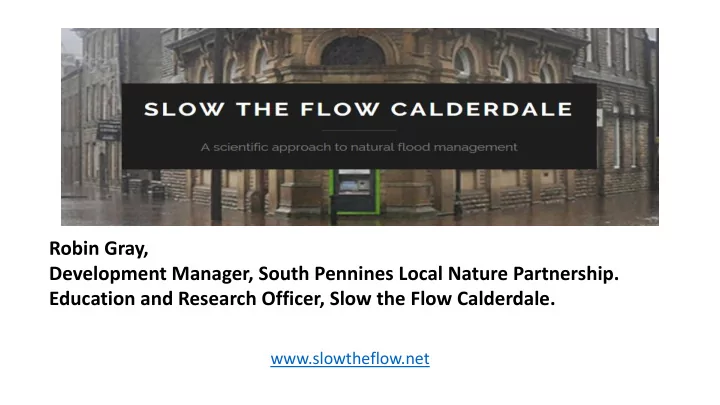

Robin Gray, Development Manager, South Pennines Local Nature Partnership. Education and Research Officer, Slow the Flow Calderdale. Project www.slowtheflow.net
BBC The Calder Valley suffered the most significant flooding event in recent times. 2,781 homes and 4,416 businesses were flooded all along the Calder Valley causing unparalleled and significant damage.
Education : Some mixed messages……. .locally! Great awareness of flooding events – but do we really understand flood risk.
Some really mixed messages……. .nationally
December 2015 Floods : What changed • Thinking on a catchment scale rather than an individual ‘town’ scale. • Recognition of how working with natural systems elsewhere in the country had mitigated impact of flooding. • A greater desire to understand. • Communities and individuals wanting to get involved.
Paul Salveson Calderdale MDC
If 10% Sphagnum cover was present in riparian buffer strips the flood peak is reduced by 7.4% also the flood peak is reduced by one time step ie 6 minutes, compared with normal conditions .
You Can Slow The Flow! Su SuDs (Su Sustainable Drainage systems)
Who are we ? www.slowtheflow.net
What do we do? • We carry out river surveys to support modelling by universities and the Environment Agency. • We communicate through workshops. • We disseminate and champion Natural Flood Management and Sustainable Urban Drainage. • We implement ‘Natural Flood Management’ schemes with willing landowners ( Hardcastle Crags Pilot Project working with the National Trust).
What have we done ? From humble beginnings……
Experimental Plate Weirs
River Surveys • Started in March 2016 River Calder • Now have nearly 20 volunteer surveyors • Almost completed Hebden Water, Crimsworth Beck and Cragg Brook • Measuring depth, width, bed surface and other features every 20 metres • Volunteers have spent c.1500 hours so far on River Surveys • All data collated to understand river network better. • Taken over 2,500 Geotagged photos on Google Earth • Information to be used by Environment Agency and river modellers • Advised to pilot one area – Hebden Water / Crimsworth Beck • Continue with surveys on Cragg Brook and beyond to build data bank • 2017 – Implementation of leaky dams / log jams / attenuation ponds and gully filling
Monitoring Success is achieved through developing simple tools for data collecting and processing communications at different levels for different audiences to advance public awareness of the issues and making the results demonstrable and measurable Oxford Flood Network
What have we done ? The e Ha Hardcastle le Crags Pilot Project ……
Hardcastle Crags Pilot Project • A Natural Flood Management Pilot Project at Hebden Water and Crimsworth Dean Beck, Hardcastle Crags • Working with the Environment Agency, the National Trust and neighbouring landowners • Small working parties to work in Hardcastle Crags • Using fallen trees and other natural materials already in situ where possible • Some tree felling as part of the longer term forestry management plan • Installation of leaky dams / log jams / re-use of mill ponds and gully stuffing • Working on brooks, ditches and the main channels • Lessons from Stroud • Eight volunteer days with • On-going Citizen Science monitoring using cameras and photogrammetry
Hardcastle Crags Pilot Project
What have we done ? • Sign up to receive Environment Agency Flood Warnings (even if you’re not in a flood zone) • Get water butts • Make water butts into ‘mini leaky dams’ in winter/potential flood events! Leave the tap open slightly. Be a Water Hoarder! • Alter your actions during flood events to discharge less water into drains (as you might in drought - e.g. shower rather than bath, wait to use the washing machine...)
What have we learnt ? • A grass-roots approach can add value: • A volunteer-led organisation can open doors that are not open to statutory services whether these are with landowners or funders; • Initiatives can support community cohesion and combat a feeling of helplessness in the aftermath of extreme events; • Support existing initiatives supplying data, labour or know-how; • However such an approach also presents challenges to existing statutory agencies in terms of identifying roles/ responsibilities, accountability, sharing information and capacity?
It t is is so sometimes har ard to o en engage wi with the the lan landscape of of stakehold lders
Recommend
More recommend